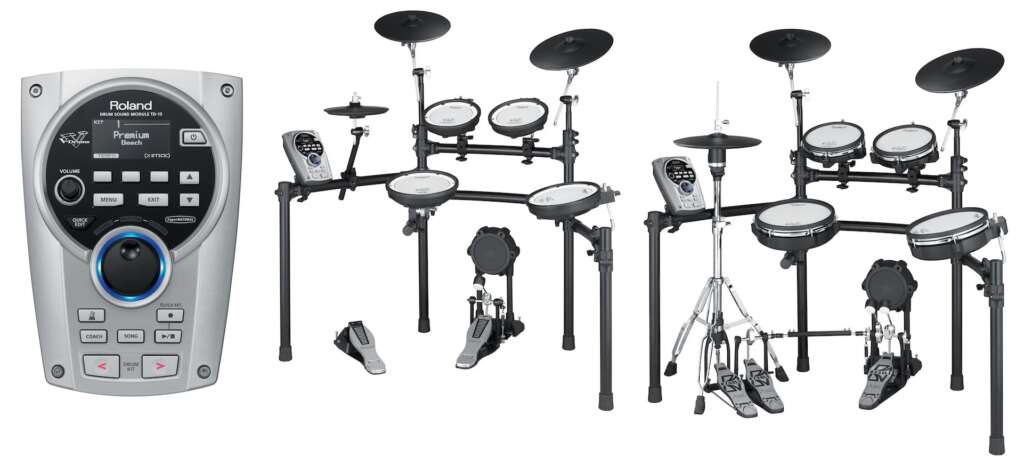Differences between Roland TD-11, 15 & 25
I get a lot of questions regarding these 3 Roland V-drums Modules/kits. Especially e-drum newbies do not spot the differences of these 3 modules and don’t really know what to buy. Therefore, I want to compare the important features of them. I focus on the relevant and important features, not the ones that are highlighted by Roland’s marketing team.
And I also want to explain the difference between “K” and “KV” sets. But let’s start with the modules first.
Relevant Module Features:

1. Trigger Inputs:
The number of pads and cymbals you can connect, is getting underestimated by so many people. At the beginning you might think 2 crashes and 3 toms are enough, but soon you want to upgrade and connect more pads. This happens to almost everyone. All kits have these standard inputs:
- Kick
- Snare
- Tom1, 2, 3
- Hi-Hat + Control
- Crash1
- Ride + Ride Bell
Additional inputs are called “AUX”.
2. Positional Sensing:
Position Sensing (PS) is a feature where the module recognizes if you hit the pad in the center or near the rim. An absolutely nice-to-have feature, which is still overrated according to many e-drummers. I however think, it is nice and allows you to play the e-snare like a real one.
3. Can we split the trigger inputs?
The Drumsplitter is basically a hack that allows you to split a 2 zone input to connect 2 pads to, let’s say Tom1. This way you are able to connect much more pads to your module. Check out this video for more information about drum splitters.
4. Can you assign instrument to head and rim independently?
This feature is important if you want to use the Drumsplitter, because it makes no sense to hear a rim click sound when hitting the cymbal you divided from the tom rim via splitter-cable. It is also useful if you want to trigger a cowbell sound or whatever on a rim.
Here is a table of the important features:
| Module | AUX | PS | Split | Assign |
| TD – 11 | 1 | No | Yes | Yes |
| TD – 15 | 2 | No | Yes | Yes |
| TD – 25 | 2 | Yes | No | No |
Unimportant features:
The number of sounds and drum kits is not really important in my opinion. Let’s be honest, how many kits will you really use? For me it would be 3 or even none, since I use my module to trigger EZdrummer2.
What do they have in Common?
All modules are compatible with the Roland VH-11 hi hat, with a 3 zone ride cymbal and each has a USB port, which can be connected directly to your PC, in case you want to trigger a drum sample software like EZdrummer2. The sounds are not great on all of them, but they are really responsive and sensitive. Every pad is a 2 zone pad with a head and rim trigger. They do also have the same audio input and output jacks.
The difference between “K” and “KV”
A Roland “K – Edition” is basically the budget version drum kit. It has only 1 crash, smaller tom pads or even rubber tom pads. The TD-11K and TD-15Khas the Roland CY-5 hi hat, which will be the first thing you want to replace after a while, since this is nowhere near the feel of a real hi hat. The VH-11 hi hat is just a must have. Especially the toms of the TD-15/25K are really small. We talk about 6”, you have to be really precise to hit these pads.
The TD-11K version is the worst decision you can make. It has a tiny rack and basically the exact same components of its former TD-4.
The “KV-Version” is more expensive, but does actually make sense. An upgrade to better tom pads and cymbals will cost more than just buying the “KV-Version”.
Conclusion:
If I would have to decide between those 3 kits, I would probably buy the TD-25KV, it might be the most expensive option, but you simply get the most out of it.
But since I am not forced to buy any of these sets, I would always go for a second hand TD-9, 12 or 20. For these budgets you are able to get a high end Roland V-drum kit of an older generation, which usually contains the exact same components. The module sounds have not really improved anyway over their latest generation. And an older Roland module can trigger EZDrummer2 too.






